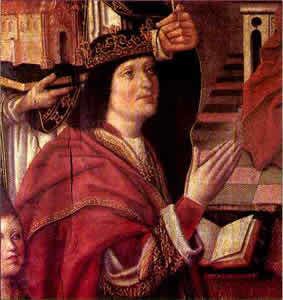Name Juan de | ||
Juan López de Palacios Rubios (1450–1524) was a Spanish jurist whose real name is Juan Lopez de Vivero. Also known as Doctor Palacios Rubios because of the village where he was born: "Palaciosrubios" (today province of Salamanca). He is the editor of the famous "requirimiento" that bears his name, read during the conquest of America to the Indians, members, instructing to submit peacefully. In the text they informed the natives that they were vassals of the Castilian monarch and subjects of the "Pope" and, if they oppose they would be subjected by force and turned into slaves.

He studied in his hometown and became a professor at the "University of Salamanca" and "Valladolid". He served as College of San Bartolome, President of the Mesta during the reign of Ferdinand and Isabella, judge of Valladolid, Minister of Council of India and Ambassador to Rome. In 1494 he was awarded the chair of premium charges at the University of Valladolid, exercising judicial functions in the chancery of the same city. Later follow the career system and reach the offices of the Royal Council member and president of the Royal Council of the Mesta (founded in 1273 by Alfonso X the Wise).
As a member of the Council of Castile from 1504, by appointment of the Catholic Monarchs, he was one of the drafters of the Laws of Toro (enacted in 1505), one of the main proponents of the issue of the Righteous Domain Titles of Castile on Indies. Specifically, in his Oceanis Insulis Libellus of legal reasoning makes a conscientious about the legitimacy of Spanish sovereignty in the American territories.
Among his works are also found military writings, most notably the Treaty of heroic war effort (Salamanca, 1524), the only work he wrote in Castilian with a distinctly political tone.
